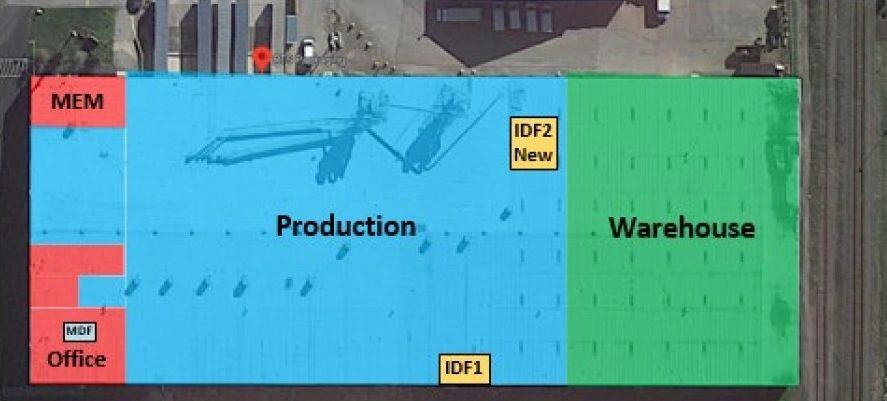
A Successful Wireless Site Survey in Pennsylvania, USA
6 March 2025
A Wireless Site Survey is a comprehensive evaluation of your radio frequency (RF) environment to identify and resolve issues that impact Wi-Fi performance. It’s not just about placing access points (APs) randomly; it’s about creating a strategic, data-driven plan to deliver consistent coverage and capacity across your entire facility.
High-performing Wi-Fi network is essential for modern enterprises, enabling seamless communication, efficient workflows, and enhanced productivity.
However, many organizations face persistent challenges such as coverage gaps, slow connection speeds, and network congestion, all of which can disrupt productivity. At a large manufacturing facility in Pennsylvania, USA, a wireless site survey proved to be the key to overcoming these issues.
By addressing signal strength limitations, channel interference, and improper access point placement, the survey provided actionable insights that transformed network performance. The result? Stronger connectivity, reduced downtime, and a more efficient infrastructure, empowering the business with a high-performing wireless network.
Lack of Redundancy and Seamless Handoff
The large scale facility comprises office spaces, warehouses, and production areas, creating a diverse and complex environment for network deployment. The size and varied nature of the facility present unique challenges for maintaining consistent and reliable Wi-Fi connectivity across all zones.
One of the primary issues reported in site was inconsistent Wi-Fi coverage across different areas of the facility. Certain zones, particularly in warehouses and production areas, experience weak or unreliable connectivity, which hampers operational efficiency. Additionally, poor signal strength was a significant concern in high-traffic areas, such as office spaces and common zones, where employees and devices are concentrated. This resulted in slow connections and disruptions, impacting productivity and communication.
Another critical challenge was network congestion caused by the high density of client devices. With numerous employees, and equipment relying on the network, the existing infrastructure struggles to handle the load, leading to slower speeds and reduced performance.
Furthermore, the lack of redundancy in the network design poses a risk of downtime, while the absence of seamless handoff between access points causes interruptions when users move between different zones. These issues collectively create a need for a robust and scalable Wi-Fi solution to ensure reliable connectivity across the entire facility.
Survey Objectives
The manufacturing facility survey was conducted with the following objectives:
-
Assess signal propagation across distinct operational zones.
-
Identify potential RF interference sources and mitigate their effects.
-
Ensure network readiness for diverse devices, including IoT, corporate endpoints, and guest access.
-
Validate structured cabling and PoE requirements for AP deployment.
-
Optimize AP placement for uninterrupted connectivity and network stability.
Survey Details
Site Details:
-
Total area: Large-scale facility with mixed-use environments.
-
Infrastructure challenges: Thick walls, machinery interference, high user density in conference rooms and break areas.
-
Devices: Desktop computers, laptops, handheld scanners, automated data collection devices, smartphones, and guest devices.

Site Map
Survey Type:
-
Pre-Deployment Wireless Site Survey to ensure optimal Wi-Fi performance before implementation.
-
The survey assessed RF propagation, signal-to-noise ratio (SNR), access point placement, and network infrastructure.
Wireless Signal Propagation and AP Placement Analysis
RF Spectrum Analysis:
-
Identification of RF interference sources, including external networks and industrial machinery.
-
Signal-to-noise ratio (SNR) evaluation to optimize transmission quality.
Heatmap Generation:
-
Predictive analysis using 5GHz propagation data.
-
Identification of coverage gaps and necessary adjustments.
AP Placement Strategy:
-
Placement based on signal propagation models and client density distribution.
-
20% overlap target to ensure seamless AP handoff.
Deployed Hardware:
-
Cisco Meraki APs for office environments.
-
Cisco Meraki APs for industrial and warehouse settings.
-
Accel-Tex Omni-Directional and Directional Antennas for optimized coverage.
Network Infrastructure Review:
-
MDF/IDF Structured Cabling: Deployment of CAT6A cabling to support 1Gb/s throughput.
-
Switching Standards: Preference for Cisco switching with 10Gb/s uplinks.
-
PoE Considerations: All APs powered through Power over Ethernet (PoE) to streamline power delivery.
Survey Findings
The wireless assessment identified several key issues:
-
Weak Signal Areas: Certain zones, including warehouses and office spaces, had RSSI below -65dBm, causing connectivity issues.
-
Channel Overlap & Interference: Excessive channel overlap on both 2.4GHz and 5GHz bands led to network congestion.
-
Inefficient AP Placement: Some Cisco Meraki access points were not optimized for coverage in production areas.
-
Suboptimal Power Levels: AP transmit power was too high, leading to increased co-channel interference.
-
Insufficient Backhaul Speed: Some APs were connected to 1Gb/s uplinks instead of the preferred 10Gb/s.
-
Additional Coverage Required: Conference rooms and high-traffic areas in office spaces need more APs.
-
Directional Coverage Needs: Warehouse aisles require directional antennas for better signal focus.
-
Interference from Machinery: Industrial equipment contributes to signal degradation, requiring mitigation.
-
SNR Degradation: Signal-to-Noise Ratio is slightly degraded in the warehouse periphery.
Solutions & Recommendations
Based on the survey findings, the following solutions are recommended:
1. Access Point Optimization
-
Adjust AP Placement: Optimize deployment of Cisco Meraki offices and warehouse APs for even coverage.
-
RF Optimization: Adjust transmit power and set AP RSSI overlap to 20% for seamless roaming.
-
Deploy Directional Antennas: Use Accel-Tex directional antennas in production areas and warehouse aisles for better signal focus.
2. Channel & Frequency Management
-
Reduce Channel Overlap: Assign non-overlapping 5GHz channels to mitigate interference.
-
Optimize SNR: Ensure SNR >25dB for high-quality connections, especially in warehouse periphery.
-
Prioritize 5GHz: Disable 2.4GHz in low-density areas to reduce interference and improve performance.
-
Reallocate Channels: Adjust AP power levels and channel assignments to limit co-channel interference.
3. Infrastructure & Security Enhancements
-
Upgrade Network Backbone: Implement 10Gb/s uplinks in MDF/IDF locations for high-speed AP connectivity.
-
Upgrade to Cat6a Cabling: Ensure structured cabling meets standards for 1Gb/s minimum port speed for all APs.
-
Optimize PoE: Ensure Power over Ethernet (PoE) support for all APs, avoiding unnecessary power failures.
-
Mitigate Interference: Strategically position APs to minimize interference from industrial machinery.
Final Thoughts & Next Steps
By conducting this Wireless Site Survey, the manufacturing facility successfully enhanced Wi-Fi coverage, minimized network congestion, and strengthened its overall infrastructure. The implementation of optimized AP placement, RF tuning, and infrastructure upgrades ensured seamless connectivity across all facility zones, reducing downtime and boosting operational efficiency.
A well-executed wireless network is critical for modern enterprises, and ensuring optimal performance requires careful planning and continuous evaluation. If your organization is facing similar Wi-Fi challenges, a wireless site survey can provide valuable insights and actionable solutions tailored to your specific needs. Investing in a strategic network optimization approach today can lead to long-term improvements in productivity, security, and user experience.
For expert assistance in enhancing your wireless infrastructure, consider a professional site survey to unlock the full potential of your network.
Please get in touch with the experts at Orion US today.

Image Source: Canva
